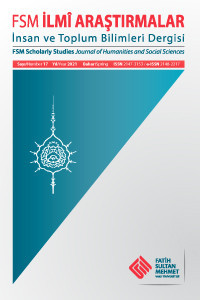Nişâbur Ekolüne Mensup Hanım Sûfilerde Görülen Fütüvvet ve Melâmet Anlayışı
Hicrî III. ve IV. Yüzyıllarda tasavvuf hareketi içinde öne çıkan sûfî ekollerden biri deNişâbur Ekolüdür. Nişâbur Ekolüne mensup sûfiler “melâmet ve fütüvvet” anlayışlarıyladikkat çekmişlerdir. Bu ekole mensup hanım sûfîlerin tasavvuf düşüncelerinde de benzereğilimi görmekteyiz. Çoğunlukla zamanın önde gelen sûfîlerinin yakınında yetişmiş olanbu hanımlarda fütüvvet; îsâr, tevekkül, eziyet vermemek, iyiliği yaymak, halka hizmet,fakirlere yardım şeklinde tezâhür etmiştir. Söz konusu hanım sûfiler tarafından melâmetde; riya endişesi, ihlâs, özel kıyafet ve törenlere karşı olma, nefsi ithâm ve aşağılamaşeklinde yorumlanmıştır.
As Members of Nishapur School, Female Sûfî’ Understanding of Futuvva and Malama
One of the sûfî-schools that played a key role in the mystical movemnet in the 3rdand 4th centuries A.H. is, of course, Nishapur School. The sûfîs who were the members ofNishapur School drew attention with their understanding of ‘Malama and Futuwwa’. It isapparent that female sûfîs who belonged to the same school cherished similar tendenciestowards mystical thoughts. Futuwwa appeared in these female sûfîs who were trained bythe sûfî-leaders who were distinguished at the time in such a way as altruism, absolutereliance on God, not causing any pain to living things or humans, making good deedswidespread, serving the public and helping the poor. Malama was viewed and characterizedby these female sûfîs as blaming and disgracing one’s own lower-self (nafs), refusingany kind of pirvate rituals and special clothes, sincerity and anxiety of hypocrisy.
Keywords:
Hypocricy, sincerity, malama, futuwwa, nafs (lower self).,
___
- Afifî, Ebu’l-Âlâ, Tasavvuf İslamda Manevî Hayat, çev. Ekrem Demirli-Abdullah Kartal, İstanbul, İz Yayıncılık, 1996.
- ISSN: 2147-3153
- Başlangıç: 2012
- Yayıncı: Fatih Sultan Mehmet Vakıf Üniversitesi
Sayıdaki Diğer Makaleler
AB’de Türk Şirketlerinin Yerleşme Özgürlüğünün Hukuki Temeli
Çerkez Toplumu Etiğinin Adler Yaklaşımının Temel Kavramları ile İncelenmesi
Cumhuriyet Dönemi Toplumsal Değişime Dair Üç Öykü: Pastırma Yazı Sır ve Kuyu
Nişâbur Ekolüne Mensup Hanım Sûfilerde Görülen Fütüvvet ve Melâmet Anlayışı
Deleuze ve Guattari’de Toplum ve Dil
15 Temmuz Hakkında Yazılmış Hikâyelerden Güray Süngü’nün “Gece” sini Tahlil Denemesi
Kendini Açma Ölçeğinin Türk Kültürüne Uyarlanması
Engelli Bireylerin Yaşamdan Beklentilerinin İncelenmesi
